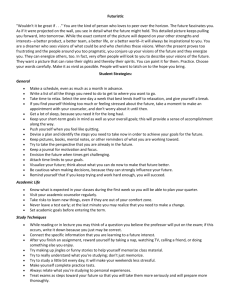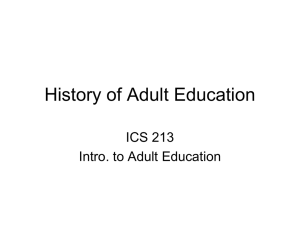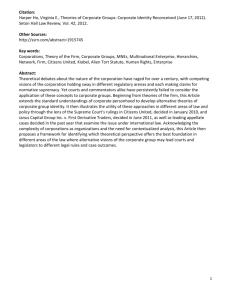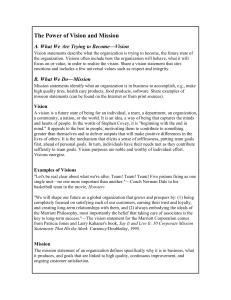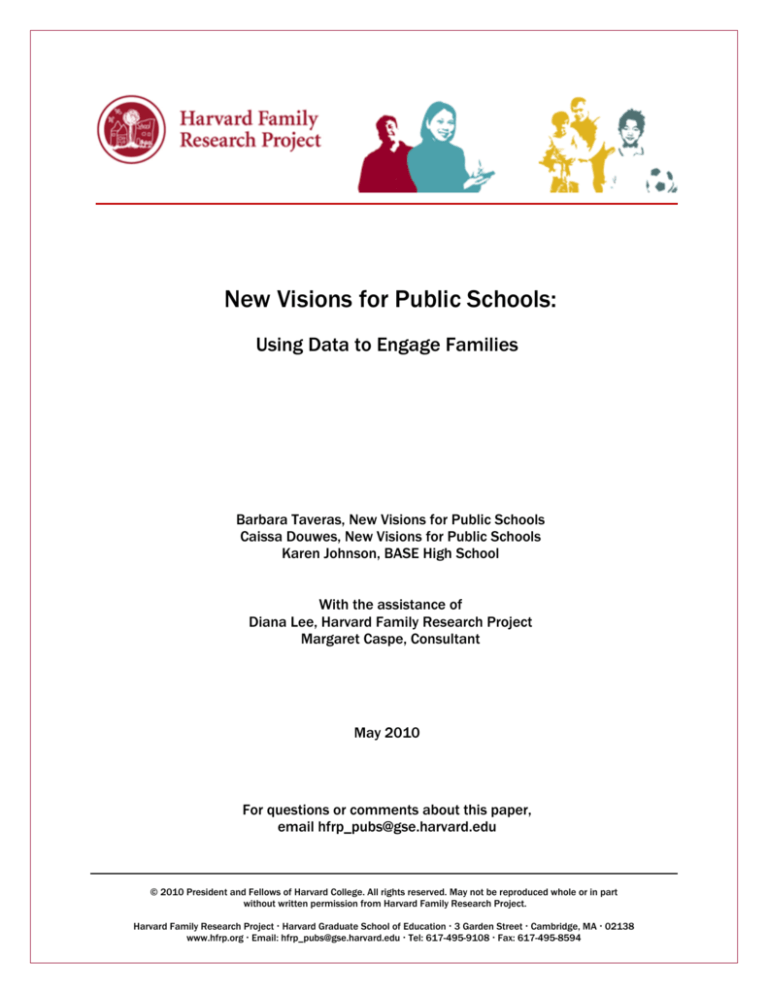
New Visions for Public Schools:
Using Data to Engage Families
Barbara Taveras, New Visions for Public Schools
Caissa Douwes, New Visions for Public Schools
Karen Johnson, BASE High School
With the assistance of
Diana Lee, Harvard Family Research Project
Margaret Caspe, Consultant
May 2010
For questions or comments about this paper,
email hfrp_pubs@gse.harvard.edu
© 2010 President and Fellows of Harvard College. All rights reserved. May not be reproduced whole or in part
without written permission from Harvard Family Research Project.
Harvard Family Research Project Harvard Graduate School of Education 3 Garden Street Cambridge, MA 02138
www.hfrp.org Email: hfrp_pubs@gse.harvard.edu Tel: 617-495-9108 Fax: 617-495-8594
The U. S. Department of Education has adopted using data for school improvement as one of its
major education reform priorities. However, as states, districts, and schools develop new
approaches to track academic progress, both accessing and understanding data are often out of
reach for average parents. While school leaders and teachers have begun to share and analyze
student data, parents are too often left out of the conversation. This is unfortunate, because data
use presents a great opportunity for parents to become involved in their children’s education with a
focus squarely on student achievement.
Caissa Douwes and Barbara Taveras from New Visions for Public Schools (www.newvisions.org)
and Karen Johnson from BASE High School in New York City share how high schools in New York
City have begun to engage families in students’ academic success and college readiness by
supporting parents in understanding achievement data. This case study makes clear that
supporting parents in grasping and utilizing this information is a shared responsibility among
schools, families, and students.
New Visions: From High School Graduation to College Readiness
New Visions for Public Schools (New Visions) was founded in 1989 and is dedicated to
improving the quality of education in New York City public schools. In 2002, operating under
the core belief that working relationships between schools, families, and communities contribute
to student achievement, New Visions spearheaded the small schools movement in New York
City. Through the New Century High School Initiative, New Visions has created a network of 99
small public schools. These 99 schools bring together nonprofits, communities, and educators
with a common goal of improving student academic performance and graduation rates.
During the course of its work, New Visions shifted its focus from on-time high school graduation
to college readiness. New Vision’s initial goals were that 80% of seniors in New Century High
Schools would receive a diploma and that each student would maintain an annual attendance
rate of 92% or higher. The first cohort of schools came close to meeting its graduation rate target.
However, after gathering post-secondary data from the first cohort of graduating seniors, New
Visions realized that students need more than just the minimum graduation requirements in
order to enter and succeed in college, or to compete for a job that pays more than the minimum
wage. Thus, New Visions raised the bar to a new goal of 80% of students graduating from high
school and entering and succeeding in college.
In 2007, the New York City Department of Education organized different systems of school
supports for the City’s public schools, and New Visions was selected to be a Partnership Support
Organization (PSO) responsible for working with 76 public schools (mostly high schools) and
accountable for the academic success of approximately 36,000 students.
New Visions for Public Schools: Using Data to Engage Families
Harvard Family Research Project
2
Transforming Parent Involvement: From Event-driven to Outcome-oriented
Historically, approaches to engaging families have been event-driven and not always designed to
involve families in a consistent and intentional way to improve student achievement. New
Visions believes that at home, parents need to be able to monitor the academic progress of their
child, as well as have access to school- and community-level resources to help each student meet
his or her academic goals. Similarly, schools need to develop the capacity to provide families with
timely, action-oriented student performance data. This includes information such as how
students are progressing toward graduation and post-secondary education benchmarks, as well
as their grades, attendance, and homework assignments. For this to happen, teachers and other
school staff need to clearly communicate academic expectations and post-secondary education
goals. Moreover, parents and schools must work together within roles that are clearly defined.
New Visions staff began asking themselves a variety of questions based on these beliefs:
•
What information and data can and should teachers provide parents, and how can this
information best be presented?
•
Can teachers and school staff co-create with families mechanisms and processes to
communicate and collaborate to improve student achievement?
•
What resources should the school have beyond learning in the classroom to support
student success (e.g., out-of-school time opportunities in community)?
New Visions decided to focus its new parent involvement efforts on ninth-grade students and
families through the creation of the 9th Grade Parent Involvement in College Readiness initiative
(see Figure 1). New Visions chose ninth grade as the target grade for a variety of reasons. First,
most students who either drop out or do not graduate from high school on time are retained in
their freshman year of high school. i Moreover, parent involvement tends to drop off in the
middle grades. Orienting and supporting ninth-grade students and parents at this important
transition point provides an opportunity for purposeful parent engagement.
Through the 9th Grade Parent Involvement in College Readiness initiative, New Visions sought
to create a foundation for purposeful parent involvement in its PSO schools. The main strategy
to achieve this goal was the creation of both school- and student-level performance data tools
and four core ninth-grade college readiness benchmarks. These benchmarks for each student
included
•
attendance rates of 92% over the course of the year
•
course grades of 80% or higher
•
completion of eleven or more credits by the end of the year
•
passing one or two New York State Regents’ exams with a score of at least 75%
New Visions for Public Schools: Using Data to Engage Families
Harvard Family Research Project
3
Figure 1. New Visions 9th Grade Parent Involvement in College Readiness Conceptual Model
These benchmarks were widely disseminated to school staff, parents and students through a
parent-friendly publication, Is Your 9th Grader on Track to College?, and the New Visions
“Aiming Higher” parent and train-the-trainer workshops.
Developing Actionable Tools: Student Data Help Parents Focus on Student
Achievement
It is difficult to engage parents in conversations about improving student achievement if they
have not been given appropriate information and tools to assess their student’s academic
progress. Parents, students, and teachers must be on the same page about what college readiness
is and what each parent needs to do to get students on a path to success. Thus, a critical
component of the parent involvement work done at New Visions involves building school
capacity to increase the use of student data in a meaningful way.
New Visions for Public Schools: Using Data to Engage Families
Harvard Family Research Project
4
In 2007, New Visions co-designed and tested with parent coordinators and parents in a select
number of schools the college readiness information and tools it now disseminates to parents of
ninth graders. What began as an effort to make complex student data useful to school
administrators and teachers led to insights on how this data could be expanded to another
important constituency: parents.
1. The School Data Snapshot: New Visions first developed and shared with school staff the
“School Data Snapshot” (see Figure 2) a simple, four-color student achievement tracking tool:
blue for college-ready, green for on track to graduation, yellow for almost on track, and red
for off track. The Snapshot allows for a quick look at attendance, course pass rates, Regents’
exam passing rates, and credit accumulation rates by student cohorts. Simplifying the data
into colors opened up among school staff a flurry of conversations that before this time were
clouded by the need to analyze numbers. New
What began as an effort to
Visions quickly understood that the conversations
make complex student data
around data could be expanded from the
useful to school administrators
administrative realm into the classroom and the
and teachers led to insights on
home so that teachers, students, and parents could
how this data could be
all use data to drive instructional change.
expanded to another important
constituency: parents.
2. The College Readiness Tracker: The College
Readiness Tracker (see Figure 3) was developed as a way for all stake-holders, and especially
parents, to quickly and easily determine individual students’ progress in various areas of
academic performance. New Visions uses this tool to consistently reinforce and remind
parents and teachers of the intended ninth grade benchmarks. The trackers are often mailed
with report cards, or distributed at parent–teacher conferences. For the 2010–2011 school
year, parents will also be able to access the tracker electronically.
One example of student data as a shared responsibility is the Bronx Latin School’s use of the
college readiness tracker. Two weeks before the 2010 winter parent–teacher conferences, New
Vision’s staff and the school’s ninth grade level team (comprised of ninth grade teachers, the
guidance counselor and the principal) conducted a workshop on college readiness for all ninth
graders and used the tracker tool to develop their goals for the term. The principal then
scheduled a New Visions parent workshop for the night of the parent–teacher conference so that
the parents of ninth graders could attend the workshop before meeting with teachers. To ensure
that everyone heard the same information, teachers as well as students attended the workshop
scheduled on the parent–teacher conference night. Teachers then met parents individually and
used the tool to give each parent a comprehensive snapshot of his or her teen’s progress before
sharing the more detailed information in the report card.
New Visions for Public Schools: Using Data to Engage Families
Harvard Family Research Project
5
Figure 2. The School Data Snapshot
Figure 2 Notes. The pie chart shows the percentage of all students in all classes who fall into the four tracking categories
(off track, almost on track, on track for graduation, and on track for college readiness). The bar chart below it breaks
down this information by particular class in both percentages and raw numbers of students. The attendance chart on the
bottom shows attendance rates by class in both percentage and raw numbers of students.
New Visions for Public Schools: Using Data to Engage Families
Harvard Family Research Project
6
Figure 3. The College Readiness Tracker
New Visions for Public Schools: Using Data to Engage Families
Harvard Family Research Project
7
Figure 3 Notes. The large chart on the left shows the total number of credits that students need to graduate broken down
by subject area (English, Social Studies, Math, etc.). The color shading system allows parents to know immediately
whether or not students are on track, and the total number of credits they have completed and in which subject areas.
For example, Aminata Marquez only has 4 of 8 credits in Math and Science and is therefore only “almost on track” in
those areas. The boxes on the right summarize this information along with attendance and Regents’ test scores.
In addition to training in using performance data, New Visions provides technical assistance to
parent coordinators and other school staff to help them align the school’s parent involvement
efforts with college readiness goals. In New York City, parent
The onus for
coordinators are full-time staff members whose main role is to
understanding student
form connections with parents and engage them in meaningful
data does not fall solely
ways. New Visions holds two day-long parent involvement
on the shoulders of
institutes for parent coordinators in the spring and fall of each
students, parents, or
school year. Institutes focus on supporting parent coordinators in
teachers; rather, it is a
working with teachers, guidance counselors, and their school’s
shared responsibility
Parent Teacher Association (PTA) around college readiness,
among all parties.
connecting coordinators with one another, and discussing new
parent involvement research and strategies. Institute workshops center on effective outreach and
engagement strategies for involving parents who speak different languages.
Putting it All Together: BASE High School as a Model for 9th Grade Parent
Involvement in College Readiness
Brooklyn Academy of Science and the Environment (BASE) High School is a public high school
located in the Prospect Heights area of Brooklyn, New York. In 2009, BASE had a student
population of approximately 450 students, with a 79% poverty rate, which qualifies it as a Title I
school. Housed on a large campus with three other small schools, BASE seeks to integrate the
resources of Prospect Park and Brooklyn Botanical Gardens, its main community partners, to
offer academic excellence and rigor to help its students become active learners in their
communities. For the past two and a half years, BASE has worked with New Visions to achieve
its college readiness and parent involvement goals. Specifically, these goals are that by 2013, 80%
of students will graduate with a Regents’ or Advanced Regents’ diploma, students will maintain a
92% attendance rate or higher, and 80% of parents will be engaged in the school’s college
readiness process.
Leading transformational change.
In the 2007–2008 school year, the New York City Department of Education published its annual
School Quality Review that characterized BASE students as lacking a sense of “urgency” in their
high school education. The report went on to characterize students as not “college ready.”
Veronica Peterson, the principal of BASE, was bothered by these findings and decided to take
New Visions for Public Schools: Using Data to Engage Families
Harvard Family Research Project
8
action. Resolving to intentionally create a culture of college readiness, in January 2008 Principal
Peterson called representatives from all the constituencies in her school—including teachers,
support staff, partners, students, and parents—to an all-day Saturday meeting which focused on
how BASE could begin to develop a culture of college readiness. With facilitation from New
Visions, the group developed a shared definition of college readiness, ideas for how to create a
college preparatory culture at the school centered on high academic expectations, expectations
for rigor in teaching and learning, and the role each constituency could play in the process.
Coordinating the initiative: the parent coordinator.
Like many other NYC public schools, BASE has a Parent Coordinator whose main role is to
connect with parents and engage them in meaningful ways in the academic life of their student
and the school. The BASE Parent Coordinator is Karen Johnson. Trained in the “Parenting
Journey” curriculum, a 12-week workshop guide designed by the Family Center in Boston, ii the
parent coordinator had already been working to build a supportive parent community. The
Parenting Journey curriculum allows participating parents to start developing a relationship with
the school built on trust and understanding, iii and allows the school insight into the family
environment. The training helped Johnson strategize about how to best engage BASE parents
with their student’s education.
In partnership with New Visions, Johnson has been focusing her work as Parent Coordinator
exclusively on engaging parents around the issues of college awareness and college readiness.
BASE and New Visions have found that the college readiness framework has helped to bring
together teachers, parents, and students around achieving the common goals of improving
academic achievement and increasing the graduation and college enrollment rates of BASE
students.
Designing innovation: the Freshman Academy.
The purpose of the Freshman Academy, created in 2009 by Karen Johnson, is to introduce ninthgrade students and their parents to the “Four Pillars for College and Career Readiness,”—the
same four benchmarks outlined in the Is Your 9th Grader on Track to College? publication—and
to motivate them to monitor progress toward the benchmarks of 92% daily attendance, a grade of
80% or higher in every course, completion of at least eleven credits and the passing of one
Regents’ exam by the end of ninth grade. The Freshman Academy also strives to build a strong
sense of community among BASE freshman and parents based on high academic expectations,
student performance data, goal setting, and action plans. An induction ceremony takes place in
the early Fall, during which ninth graders and their parents sign a contract committing to
working towards the four pillars. Students and parents take an oath during a candle-lighting
ceremony to support each other in reaching these goals.
Parents also have opportunities to become involved in the BASE college readiness initiative
through becoming parent leaders. The freshman class is divided into four cohorts, each with a
New Visions for Public Schools: Using Data to Engage Families
Harvard Family Research Project
9
teacher/advisor, three student leaders, and three parent leaders. Parent leaders for each cohort
are responsible for contacting all cohort parents to keep them abreast of school-wide events,
important dates, parent workshops, and, most importantly, their cohort data. Parent leaders are
also tasked with supporting each other in overcoming barriers toward the success of students in
their cohort. Each cohort’s student leader helps guide his or her peers towards greater academic
achievement using shared and individualized data. The teacher/advisor meets with the cohort of
students at least once a week to focus students on their attendance and academic achievement
through a variety of activities based in part on the curriculum of Roads to Success (a collegereadiness program introduced to BASE by New Visions). To assist the students in getting on the
pathway towards college, New Visions conducted college readiness sessions with each ninthgrade cohort to help them understand the benchmarks, set goals using their own student data,
and create a plan to achieve performance goals.
Along with each of these opportunities, a variety of workshops and social events are also offered
to parents throughout the school year. Two of the most important include the Snap Grades and
ARIS workshops. During the Snap Grades workshop, parents learn how to use an online grade
book that allows them to see grades and attendance on a daily basis. This system also provides
real-time alerts via e-mail. The ARIS workshop is provided to help parents navigate the
Achievement Report Innovation System (ARIS), a student performance database developed for
parents by the New York City Department of Education.
Engaging stakeholders.
As relationship-building with parents—structured around college readiness—grew, the need
became apparent to connect this work to existing parent involvement structures such as the
Parent Association (PA)/PTA and the School Leadership Team. The first group of parents who
graduated from Parenting Journey all became officers in the PA. In addition, other school-based
structures emerged as essential partners in connecting parent involvement to student
achievement. Although each group at first had separate agendas, by bringing them together
under the umbrella goal of college readiness, BASE was able to create a web of supports for
students to build and sustain capacity for college readiness goals in the school. These structures
include
•
Inquiry Team: A group of teachers who focus on improving the achievement of
underperforming students (the bottom one-third of students in the school) by examining
performance data on a regular basis and using the data to drive academic interventions.
•
School Committee: Comprised of the principal, a teacher from each subject, the parent
coordinator, the school’s community partners, and student representatives, the
committee meets regularly to discuss pressing school-wide issues.
•
PA/PTA and School Leadership Team: Both bodies engage parents, meet regularly, and
define areas of concern and goals for the school community.
New Visions for Public Schools: Using Data to Engage Families
Harvard Family Research Project
10
•
Grade Level Teams: Comprised of teachers from a given grade, the committee meets to
examine cohort data and identify students that might be having difficulty.
•
Guidance Counselors: Staff members who counsel and guide students in grades 9 and 10
and grades 11 and 12.
•
Data Specialist/Programmer: A math teacher who enters the student data and works
with New Visions to examine and present the data in a clear way to teachers, students,
and parents.
•
Attendance Teacher: A music teacher who is in charge of tracking daily student
attendance. The attendance teacher finds students who are considered “long-term
absences” through creative and unique ways (e.g., Facebook, Twitter, home visits).
Conclusion
As using data to improve student achievement becomes an increasingly important aspect of
education reform, it is critical that parents become integral partners in this process. The New
Visions case presented here shows how families, schools, and students can come together to use
the power of data to support student achievement. By supporting families in understanding
student data, utilizing performance tools, and learning about specific college readiness
benchmarks, New Visions creates concrete, practical, easily-accessed ways for parents to become
involved in their students’ education. Moreover, by acknowledging that family involvement roles
are always co-created, New Visions works with schools to develop the capacity to provide
families with student performance data in timely action-oriented ways. The case of BASE high
school serves as a reminder that families and schools must share the responsibility for this
meaningful work to be successful. Put differently, a commitment to parent involvement must
extend over time not as a one-stop workshop, but as a concrete multi-party effort over the course
of years and with opportunities for the entire school community to learn and grow together.
For more information contact:
Barbara Taveras
Director, Community Engagement
New Visions for Public Schools
Tel: 212-645-5110
Karen Johnson,
Parent Coordinator
BASE High School
Tel: (718) 230-6363
Information for this article was taken from a presentation at the United Way Worldwide and AT&T’s Family
Engagement for High School Success meeting in Cambridge, MA, December 7–8, 2009
i
Allensworth, E. & Easton, J. Q. (2007). What Matters for Staying On-Track and Graduating in Chicago Public
Schools. Consortium on Chicago School Research. Available at:
http://ccsr.uchicago.edu/content/publications.php?pub_id=116
ii
The Family Center. Online at: http://www.thefamilycenterinc.org/index.html
iii
Bryk, A. S., & Schneider, B. (2002). Trust in Schools. New York: Russell Sage Foundation Press.
New Visions for Public Schools: Using Data to Engage Families
Harvard Family Research Project
11

